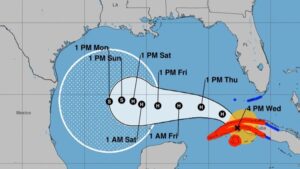
The storm struck western Cuba on November 6, having intensified rapidly prior to its arrival. With maximum sustained winds of 115 mph, Rafael is the fifth hurricane of the Atlantic season to reach Category 3 status.
The hurricane’s impact has been felt across the island, where wind gusts exceeding 70 mph were reported in Havana. This latest storm adds to Cuba’s challenges, as the nation is still recovering from Hurricane Oscar, which struck two weeks earlier and resulted in several fatalities and widespread power outages.
As Rafael approached, authorities issued warnings of life-threatening storm surges and heavy rainfall, which could lead to flash flooding and mudslides in vulnerable areas. The Cuban Civil Defense urged residents to prepare for the storm and emphasized the importance of staying indoors once it made landfall. Evacuations were ordered for approximately 37,000 people in the Guantanamo province due to adverse weather conditions.
After making landfall, Rafael is expected to weaken as it moves into the Gulf of Mexico, where it will encounter unfavorable atmospheric conditions such as strong wind shear and cooler waters. However, forecasters caution that the storm could still pose a threat to the Florida Keys as it continues its path.
As Rafael progresses through the Gulf, its potential impact on the U.S. remains uncertain. Meteorologists are monitoring its trajectory closely, with predictions suggesting it may weaken significantly before reaching the U.S. Gulf Coast or northeastern Mexico later in the week.
In summary, Hurricane Rafael’s landfall in Cuba marks a significant weather event for the region, compounding existing recovery efforts from previous storms while raising concerns about flooding and infrastructure resilience as it moves forward.

Leave a Reply